Periodic breathing or Cheyne-Stokes breathing (abbreviated as CHS) is a syndrome in which the respiratory rate changes. This is a condition in which respiratory movements first slow down and then speed up.
Changes usually occur at about 5-7 breaths. This is followed by a pause and the cycle repeats. The pathology received a similar name in honor of doctors John Cheyne and William Stokes. They were the first to describe a similar syndrome back in the early 19th century.
Record content:
- 1 Features and symptoms of Cheyne-Stokes breathing
- 2 The mechanism of shallow breathing
-
3 Reasons for the appearance
- 3.1 Non-pathological etiology
- 3.2 Pathological etiology
- 4 What diseases can be accompanied by Cheyne-Stokes breathing?
- 5 Why does shallow breathing appear before death?
- 6 At-risk groups
- 7 Which doctor should I go to?
- 8 Diagnostics
- 9 Breathing disorder treatment
- 10 Forecast
- 11 Video about abnormal breathing
Features and symptoms of Cheyne-Stokes breathing
At first, the symptoms are very weak. A person breathes intermittently, after which breathing becomes more intense, deep. Gradually, the respiratory rhythm becomes more confused, noises appear.
Due to the insufficient amount of oxygen in the lungs, a person may begin to experience at first slight anxiety, and as the pathology develops, even panic attacks. During sleep, the patient can scream, flinch, wake up abruptly. Periodically, breathing stops for 5-10 seconds. Later, this period of time can increase up to 1 minute.
Such pauses can be easily identified by the immobile chest of the sleeper. This period (respiratory arrest) is called apnea. During a prolonged respiratory pause, a person does not show any reflexes. A sharp reaction appears only at the moment of the repeated onset of respiratory activity.
Cheyne-Stokes breathing is a disorder in which the following symptoms are observed:
- Decreased heart rate.
- Clouding of consciousness. Due to the lack of oxygen entering the brain, a person may feel semi-faint.
- Blanching of the skin. As a rule, this manifestation becomes most noticeable during the period when a person's breathing stops completely. The longer these periods of apnea, the more the skin turns pale.
- Constriction of the pupils. In addition, a person may not respond to various stimuli, for example, a beam of light.
- Dilation of the pupils during the period of the so-called hyperapnea.
- High blood pressure.
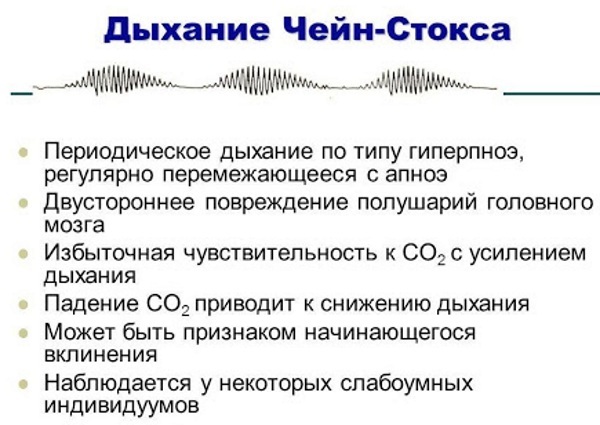
Twitching is observed during sleep in patients suffering from this disorder. This can involve the muscles of the face or body. With a more advanced stage of the pathology, the patient may moan in his sleep, rush about the bed. As soon as breathing is restored, the person feels much better and sometimes does not even remember that he was jerking his hands or flinching.
Also, with this disorder, after sleep, it is difficult for patients to immediately sit up or get out of bed. Severe shortness of breath appears. In the morning, people with intermittent breathing syndrome often complain of anxiety. However, they cannot indicate the exact reasons for their nervous state. This is also due to the lack of oxygen that the brain receives.
If we talk about the features of this syndrome, then it is worth highlighting that it can manifest itself sporadically. For example, a person may only complain of discomfort at certain times of the day or night. Some do not even notice that their breathing becomes intermittent during sleep.
In the most dangerous situations, pathology begins to develop rapidly. Respiratory pauses are getting longer and longer. As a result, holding the breath becomes so long that there is a serious risk of death.
Often, such manifestations negatively affect the psychological state of the patient. The person begins to be afraid to sleep. He may develop insomnia, which can also aggravate the situation.
The mechanism of shallow breathing
Cheyne-Stokes breathing is a syndrome that does not have a clear development mechanism. It all depends on the physiological characteristics or the presence of pathologies in a person. For example, shallow breathing can appear against the background of changes in the content of carbon dioxide in a person's blood.
As a result, the respiratory muscles do not receive the necessary impulses, which usually provoke its activity. If the gas exchange process is not carried out in the lungs, then the amount of carbon dioxide increases until it reaches the peak of the sensitivity of the respiratory centers. As a result, breathing is restored and gradually all body systems begin to work as usual.
In the process of hyperventilation, the removal of carbon dioxide is carried out through the lungs, due to which the concentration of this substance decreases. If the withdrawal of the substance occurs too actively, then this condition is usually called hypocapnia.
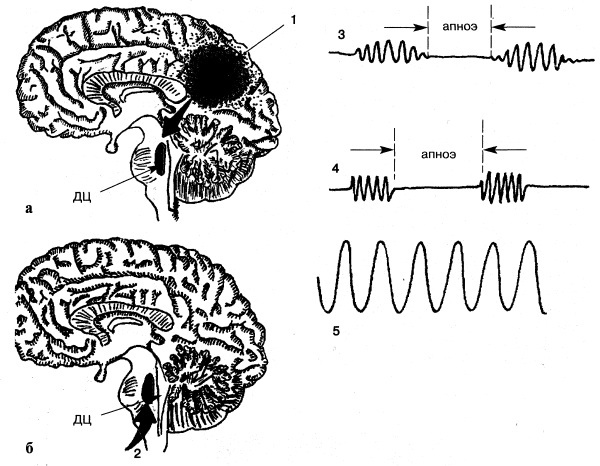
In this case, carbon dioxide ceases to irritate the respiratory center, due to which there is first a weakening, and then a complete stop of the respiratory process.
The respiratory system is influenced not only by carbon dioxide, but also by oxygen. When there is a decrease in the partial pressure of H2O in the blood of a person, he begins to breathe more often.
However, if hypoxia lasts too long, respiratory arrest occurs. Insufficient oxygen levels cause brain cells to begin to change or die off. This can cause serious harm and cause irreversible changes.
Reasons for the appearance
As a rule, with DSChS, experts do not note the presence of chronic heart failure in patients. More often, alarming symptoms appear in those people who suffer from circulatory problems.
Non-pathological etiology
Based on this, 3 factors can be distinguished that most often cause respiratory distress:
- The heart pumps less blood, the brain stops receiving the required amount of oxygen. Blood moves more slowly from the lungs to the brain if the myocardium does not contract actively enough. This has a negative effect on the respiratory center.
- The respiratory center is insufficiently stimulated by carbon dioxide due to its lack.
- A person suffers from spontaneous excitations of the respiratory centers against the background of a disorder of the central nervous system.
Additional factors that can disrupt respiratory processes include smoking, excessive consumption of alcoholic beverages. That is, the intoxication of the body is also capable of provoking the DSChS syndrome. Also, the cause of the pathology is sometimes a lowered intracranial pressure.
Shortness of breath is often a consequence of high doses of sedatives. Also, people who have suffered from long-term inhalation of carbon monoxide, which is formed during combustion, face a similar problem.
Often this type of pathology is diagnosed in people who live in mountainous areas. As you know, in such regions, the oxygen content in the air is lowered. This provokes the development of the syndrome.
Pathological etiology
Cheyne-Stokes breathing can be caused by some pathological conditions. This means that there are a number of pathologies that can lead to problems with the rhythm of breathing.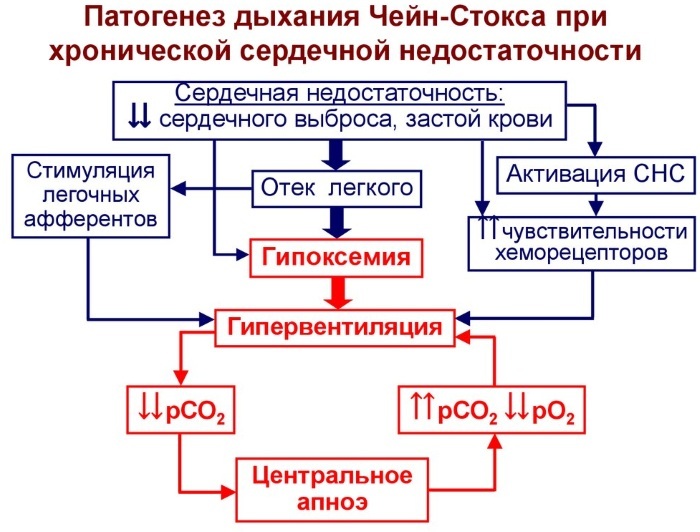
DSChS can develop against the background of:
- Diabetic coma. In this case, there is not enough insulin in the human body, due to which the concentration of glucose in the blood increases significantly. This condition leads to the so-called hunger of peripheral tissues. As a result, the liver begins to produce glucose, and other processes hazardous to health develop.
- Uremic coma. This is another type of terminal condition in chronic pathologies that disrupt the functioning of the kidneys. With uremic coma, the main functions of the central nervous system are inhibited.
What diseases can be accompanied by Cheyne-Stokes breathing?
In some diseases, DSES is one of the symptoms.
Intermittent breathing can form due to:
- Atherosclerosis of the vessels of the brain.
- Chronic azotemic uremia. We are talking about autointoxication, which can develop against the background of renal failure, when too many metabolites are retained in the human body. With this diagnosis, DSChS almost always develops.
- Pathologies affecting the brain. For example, breathing problems can occur due to thrombosis or cerebral embolism. Also, shallow breathing is often observed in patients who have suffered a cerebral hemorrhage, meningitis.

Cheyne-Stokes Respiratory Disease - Acute infectious diseases. DSChS is one of the consequences of influenza, typhoid, diphtheria or pneumonia. The symptom often develops at the terminal stage, that is, when there is a failure in metabolic processes.
Why does shallow breathing appear before death?
This happens against the background of irreversible changes in the body, which affect the deterioration of not only the respiratory system, but also many other systems. For example, a person may have hearing or vision problems. He loses his appetite, sleeps a lot, and may be in a coma. Changes affect the urinary system, the normal functioning of the gastrointestinal tract stops.
It all depends on the specific diagnosis in which doctors cannot save a person. As a rule, changes in breathing are associated with damage to the lungs themselves, the central nervous system, the brain, and the heart. Breathing can stop completely at times. The person looks weak, every breath is given to him with great difficulty.
On the verge of approaching death, DSChS may develop due to congestion in the lungs. Liquid begins to accumulate in them. It is very difficult to remove it. The doctor may try to relieve the condition with drugs that reduce the discomfort of congestion, but the respiratory system usually does not fully recover.
At-risk groups
Cheyne-Stokes breathing is a syndrome that can develop in everyone, regardless of age or gender. Also, doctors were unable to identify a separate risk group, which would include patients with similar physiological characteristics. Thus, it is very difficult to predict who will be affected by a given problem and who will never face it.
It is also worth highlighting some categories of people whose minor manifestations of DSES are considered the norm. These include children and the elderly who have similar manifestations during REM sleep. With the onset of the phase of slow sleep, the signs of DSChS disappear.
Accordingly, in this case, drug or other therapy is not required. In young children, the presence of signs of unstable breathing is due to the fact that the central nervous system has not yet been fully formed. Elderly people are faced with dystrophic and degenerative functions of the nervous system, which also manifests itself in intermittent breathing during REM sleep.
If a person has breathing problems outside of sleep, then this usually indicates other pathologies or factors that provoke similar symptoms. For example, older people are more sensitive to changes in atmospheric pressure and air temperature. At too low or high values, it becomes more difficult for them to breathe.
Which doctor should I go to?
It all depends on the reasons, against the background of which problems with the respiratory system appeared. If a person suffers from heart problems, then it is necessary to consult a cardiologist. Most often, problems with the central nervous system become the cause of DSES. This direction is dealt with by a neurologist.
As a rule, when alarming symptoms appear, a person first turns to a therapist. He, in turn, makes a preliminary history and issues a referral to a highly specialized specialist.
Diagnostics
An important step in the initial diagnosis is the correct identification of the symptoms of DSES. The person himself cannot accurately describe what happens to him during sleep.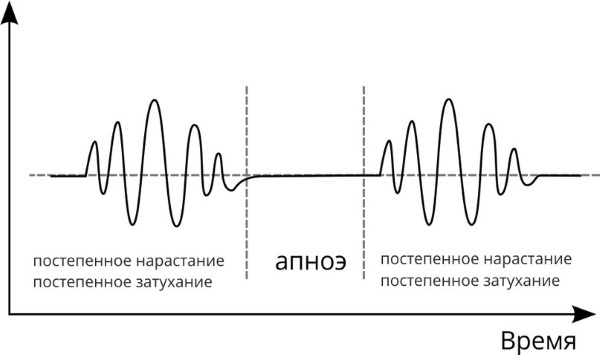
He can only complain about insomnia, restlessness and the fact that he wakes up abruptly in the middle of the night. As a rule, in order to get a complete clinical picture, the doctor conducts a conversation with the patient's relatives, friends, or those who can observe him during his sleep.
If this is not possible, then the patient is left in a medical institution, where his respiratory system is monitored during the moments of rest. The doctor may ask the nurse about the patient's breathing patterns or use equipment that will record any significant changes.
If the syndrome is pronounced, then breathing disorders can be observed while the patient is awake.
Also, in the process of diagnostics, a number of studies are carried out:
- Measurement of indicators of partial pressure of carbon dioxide. During the examination, the patient is asked to take a horizontal position and relax. If the indicators are low or below the norm, then this is a clear sign of the presence of DSES.
- An examination aimed at assessing the condition of the patient's lungs. Based on the test results, the doctor determines whether the patient suffers from hyperventilation or other manifestations of DSChS.
If, according to the results of these tests, it becomes obvious that the patient may have Cheyne-Stokes breathing, the doctor prescribes a number of additional diagnostic measures.
For example, he can write an ECG referral. This study will determine if the patient suffers from chronic heart failure or other problems in the work of the cardiovascular system. Additionally, a chest x-ray is taken, an MRI of the brain may be required.
There are also a number of specialized tests that are carried out to determine the presence of an ESP.
| Survey name | Peculiarities |
| Night pulse oximetry | The method is aimed at determining the presence of desaturation. For research, the patient is placed in a medical institution and during his sleep (at night), equipment is used to saturate the body with oxygen. |
| Multichannel sleep study | With the help of special sensors that are connected to the patient's body, the doctor determines whether there is an effort to breathe in the apnea phase. |
| Babinsky test | During the patient's sleep, an irritant (for example, a feather) is brought to his foot. If, as a reaction, only the big toe is unbent, then this indicates the presence of a DSChS. If a person does not suffer from this syndrome, then contractions will be in all the toes of the foot.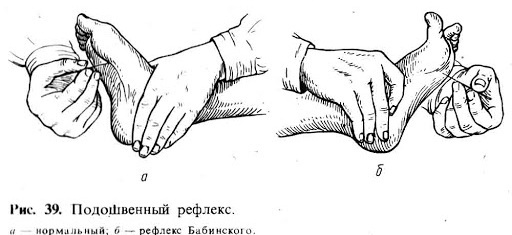
|
Babinsky's test is quite simple, so it can be done at home as well.
Breathing disorder treatment
Cheyne-Stokes breath is a syndrome that can be treated, but only if it has been correctly diagnosed. As a rule, Aminophylline is most often prescribed to patients. The drug is a solution for injection. The dosage is determined by the doctor.
Aminophylline is prescribed for various manifestations of asthma, apnea, pulmonary emphysema.
Also, the tool is effective against DSES. This drug is not recommended for those who suffer from arrhythmias, arterial hypertension, hypersensitivity. The remedy is contraindicated in patients who have recently had myocardial infarction and those who have been diagnosed with a chronic degree of gastritis, ulcers, and gastrointestinal diseases.
Also, adaptive servo ventilation is carried out as a therapeutic measure. This method of treatment consists in the use of special breathing apparatus that patients use while sleeping. The devices are able to stimulate the pressure of the air flow during inhalation and exhalation.
As a result of such treatment, the work of the heart improves, the myocardium begins to contract more intensively. In addition, the pressure is stabilized, and the clinical manifestations of difficulty in breathing disappear.
Also, the doctor may prescribe artificial ventilation of the lungs. It can also be done at home. The most effective devices are CPAP and BiPAP. Externally, the equipment is very similar, however, the two methods of treatment are different.
CPAP devices allow you to maintain constant pressure in the lungs. As a result, the forced air stabilizes the upper respiratory tract. However, this is not always enough to solve the problems of emergency situations. BiPAP is a more effective treatment algorithm. In this case, the device generates different levels of air flow pressure based on the breathing phase.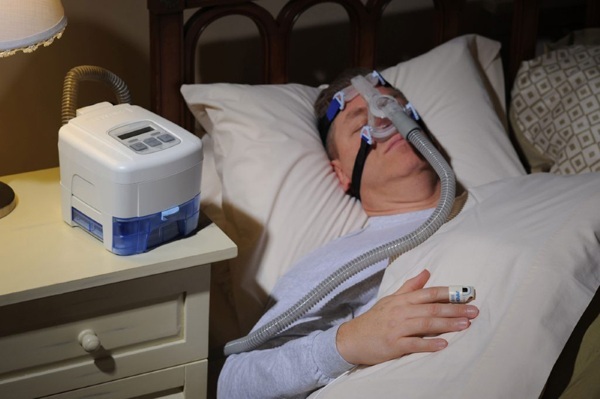
Low-flow oxygen therapy is also used. Based on this, the most effective methods in the treatment of this syndrome are those that are aimed to maintain the correct circulation of air flows in the lungs through the use of a special equipment.
The devices are compact and applicable at home. At first, the patient may feel uncomfortable with the use of such devices, but when the symptoms of intermittent breathing have subsided, patients experience significant relief.
Forecast
The danger of DSChS depends on the state of health of the individual patient. According to statistics, the highest mortality (up to 30%) from this syndrome is observed in people who suffer from heart failure.
With vascular diseases, the prognosis is more favorable. As a rule, nothing threatens the health of patients with such a diagnosis if therapeutic measures have been taken to stabilize the work of the respiratory system.
If, at the same time as DSChS, the patient suffers from an infectious disease or pathologies that affect the brain, then it is very difficult to predict any outcome. If breathing problems are observed in patients during periods of wakefulness, then this is a more dangerous condition. With DSChS exclusively during sleep, there is a much greater chance of recovery.
If the patient has been suffering from apnea and symptoms of DSChS for a long time, then this can provoke hypoxia. The protective functions of the body decrease, oxidative processes begin in the tissues.
If signs of Cheyne-Stokes breathing appear, you should consult a doctor and take the necessary diagnostic measures. This syndrome can be extremely dangerous, therefore it is important to timely establish the work of the respiratory system and determine which pathological conditions could provoke breathing problems.
Video about abnormal breathing
Breath sounds and auscultation of the lungs:



